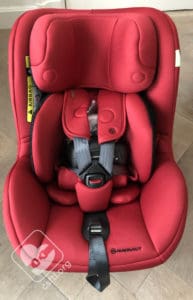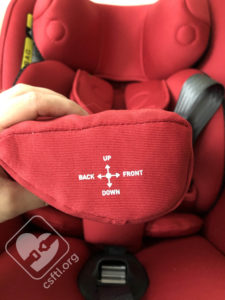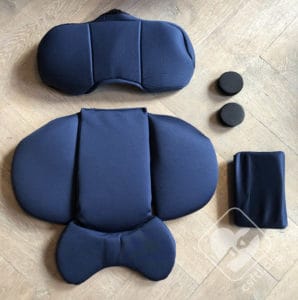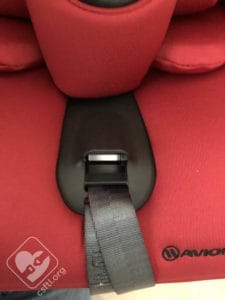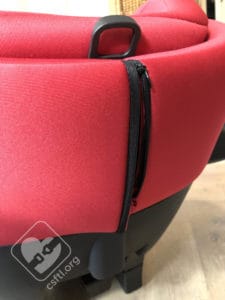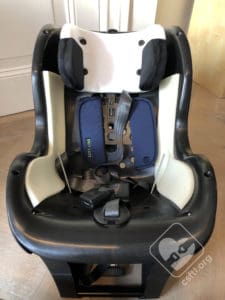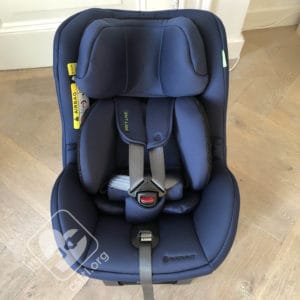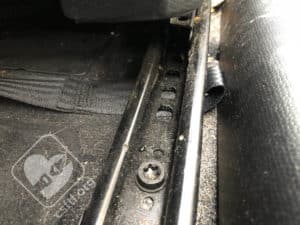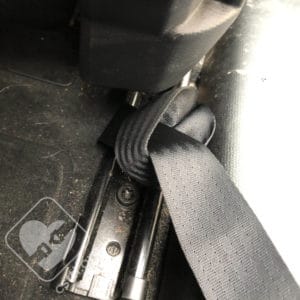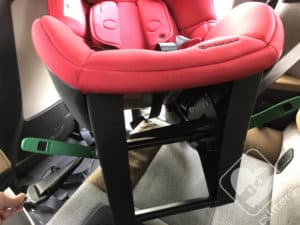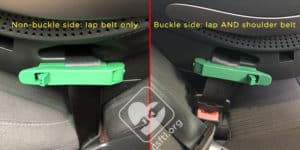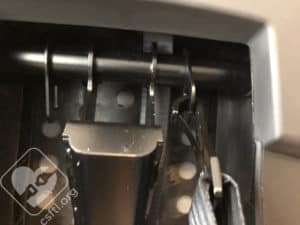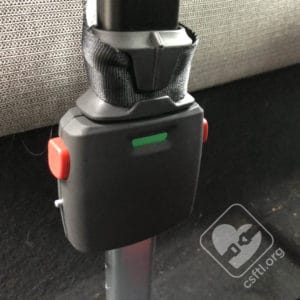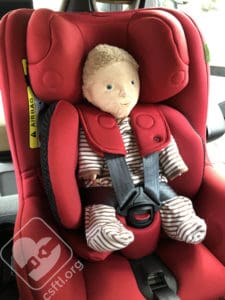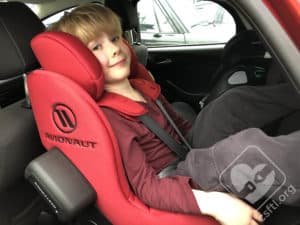We first encountered Avionaut at 2019’s Kind & Jugend trade fair. Their light-as-a-feather Pixel infant seat intrigued us, but the news of a new birth-to-25-kg rear facing only car seat had us really excited. Now we’ve finally had the chance to try out the Sky, so let’s see how it stacks up!
CSFTL Quick Stats
- Rear facing weight range: 0-25 kg
- Rear facing height range: 40-125 cm
- Expiration: Avionaut recommends a maximum of 10 years of use
- Avionaut recommends replacing the seat after a crash. In some cases, Avionaut may replace your seat free of charge if you meet certain requirements
- R129 compliant
Measurements
- Lowest harness position: About 22 cm with insert; 31 cm without insert
- Highest harness position: 41 cm
- Depth front to back: About 73 cm (measured from back of car seat to vehicle seat back)
- Width at widest point (shoulder area of the seat): 46 cm
- Weight: 6.6 kg
- Seat pan depth: 33 cm
R129 Compliance
Our readers who are not in Europe may wonder what this means. Here’s a quick recap. Up until 2013 car seats were regulated under a set of standards known as R44. Starting in 2013 new standards under R129 were gradually phased in. For now R44 and R129 are both legal standards, but all brand new seats to the market may only be approved under R129 (“upgrades” of older R44 seats are not required to comply with R129 standards).
R129 brings in stricter side impact testing, and changes from a purely weight-based classification of car seats to more of a height-based classification (though weight limits are often still in place).
Rear Facing Only
The Sky is a rear facing only seat, so it doesn’t have a forward facing mode. However, it has higher limits than other seats on the market, and should keep most children safely rear facing until they’re ready for a booster. Since rear facing is the safest way to travel, it’s great to have long lasting options in Europe to keep children as safe as possible for as long as possible!
Initial Impression
The very first thing I noticed about the Sky is that it’s incredibly lightweight. At only 6.6 kg, I was able to easily lift it out of its shipping box with one hand. There are not a lot of seats I can say that about! I also loved the red cover; several other colours are available, and it’s always so nice to have more choice than black or grey.
I also noticed that there is a lot of padding – on the crotch strap, grippy pads on the shoulder harness, even padding on the hips. And the hip padding serves an extra purpose: it has a stiffness to it that keep the harness up a bit, helping to stop the harness from getting stuck underneath the kiddo during loading.
Insert
Avionaut uses an insert system which is unlike most other inserts on the market. Instead of the harness adjusting to lower heights to accommodate smaller babies, the Sky has a chunky shelf-like insert to prop babies up higher so the harness sits correctly. According to Avionaut, this shelf-like cushion also helps to provide an ergonomic position for a young baby’s back and hips.
One very nice feature of the Sky’s insert system is that it’s customizable to the child using it. Unlike many inserts that have strict height maximums and must be removed all in one go, the Sky’s insert can be used as long as it improves the child’s fit.
The first bits of the insert to come out are the hard polystyrene circles that are attached by hook-and-loop at the back of the shoulder area. Later, the sides of the insert pull off of the back, and the cover on the headrest pulls off. By the time the child is a toddler the entire insert is out to provide more room.
With the insert removed there is definitely less padding in the seat – the sides of the headrest are still quite cushy, but there’s very little padding at the back of the headrest. However, our main model still finds it very comfy!
Of course, with all these different pieces it’s easy to lose track of something, especially if you plan to pass the seat down. A clearly labelled box or bag that you can pop things in as you take them out is a good idea!
Harness
In most cases, harness webbing types fall into roughly two categories – fairly stiff and a bit rough, and very flexible and smooth. The Sky has the flexible and smooth type of webbing.
The smooth type is significantly more prone to twisting, since it’s so easy to have it accidentally fold over in the buckle while tightening. However, it’s much softer against a child, so children who are particularly sensitive to things pressing on them may tolerate it better. I do find I have to be very careful not to accidentally cause a twist in the Sky’s harness while tightening, but since I’m aware of the possibility it hasn’t been an issue so far.
The harness itself is pretty hard to tighten – while my fiance has no trouble pulling it tight, I find I have to put a bit more effort into it than I’m used to.
To release the harness, use one finger to push the lever towards the back of the seat (or towards the front of the vehicle), then pull the harness out below the harness padding with the other hand. The harness release is quite deep inside the seat, which is great to deter little fingers who are intent on escaping. On the other hand, in some vehicles, it can be difficult even for big fingers to get the leverage required to release it.
To adjust the harness height, pull on the tab at the top of the headrest and move it up or down. It’s very easy to move, and there are plenty of adjustment levels to help you find the right setting with the harness just at or very slightly below the tops of the child’s shoulders.
Recline Adjustment
The Sky is different from most other car seats in that it has a fixed recline angle which you can’t change. This means that the actual recline angle will vary from vehicle to vehicle based on how sloped the vehicle seats are. What this means in practice is that the Sky may not be suitable from birth in all vehicles, since it may not offer a sufficiently reclined angle for newborns. We would recommend checking the angle of the car seat backrest before using it with an infant who doesn’t yet have good head control – it should be no more upright than about 45 degrees for the tiny ones.
Tethers
Like all other seats that rear face up to 25 kg, the Sky requires lower tethers. Often this can seem like the most daunting part of install, but it can actually be pretty easy if you know your options.
The manual for the Sky only shows tethering under the runners of the front seat, but we checked with them and it’s also fine to tether through the front seat. This is especially helpful if you need to give more legroom to the front.
Additional tethers are also available in case you frequently need to move the Sky to another vehicle. Just leave the tethers attached, then quickly clip them on when you need them.
Load Leg
The load leg on the Sky is very close to the seat, meaning it doesn’t require much room at all in the vehicle. In fact, the entire seat is extremely compact – that small footprint makes the Sky a great option for smaller vehicles!
Pro tip: At the back of the seat there’s a little “shelf” that seems like an ideal handhold for carrying it. DO NOT DO THIS. I like to call that shelf the finger crusher, because I keep forgetting that it is a very bad place to put my fingers. The load leg swings down and against that shelf, and if your fingers are in the way they will be squished. Sometimes multiple times, and always with rather loud swear words.
If you extend the load leg a bit underneath the seat, one of the crossbars on the bottom will hold the leg so it doesn’t swing up and squish your fingers. Or just avoid the finger crusher on all accounts!
Changing the Cover
There’s one thing that always gives me a shiver of anxiety whenever the idea creeps into my brain – removing a car seat cover for washing. I hate it. I almost never do it because I always find it such a complete and utter pain.
But since Avionaut sent me a beautiful dark blue extra cover for the Sky, I decided I owed our readers a report on the cover-changing experience. That, and with a potty training toddler I know it’s something I should probably get a head start on practicing.
Overall, removing the cover wasn’t as bad as I expected. Pulling the cover off was easy – first remove the cover from the headrest (elastic bands hold the back flap to the shell), then unzip the cover at the rear of the seat, unsnap the cover where the child’s back goes, and pull it out from the edges. Getting a naked seat takes almost no time at all.
Putting the new (or newly laundered) cover on was a bit more challenging, but not as difficult as other seats I’ve had. The trickiest part was tucking the edge of the cover into the shell – I found that the trick was pulling down the cover so I had plenty of slack, then using a dull plastic child’s butter knife to tuck it down into the gap. Once I figured that out the second side went pretty quickly. And isn’t the new blue cover lovely??
Installation – VEHICLE SEAT BELT ONLY
The Sky is seat belt install only – there is no ISOFIX option. The load leg and lower tethers must be used at all times.
First, decide where you want to place your lower tethers. A good choice is under the front seat runners – in the BMW i3 there’s a very handy gap which makes it very easy to thread the tether under.
Slide the loop end (not the hook end or the tail you pull to tighten the hook end) under the runner and behind the structural bolt, then put the hook end through the loop and pull tight. Do this on both sides. If you’re installing in the middle of the vehicle, put the tethers under the inside rails from the two front seats.
Alternatively, you can tether through the seat in front or even to the seat it’s on. To tether through the front seat, slide the loop end of the tether through the crack between the seating area and the backrest of the front seat. Then put the hook end of the tether through the loop and pull tight. Do this on both sides of the front seat.
Now, leave the tethers for a minute – we’ll come back to them shortly!
Next, place the Sky rear facing on the vehicle seat with the load leg swinging freely behind it. Make sure the front of the car seat (where the child’s feet will go) is up against the vehicle seat back.
Open both green lockoffs. Push the tab on the lockoff to allow it to pop open.
Pull the vehicle belt out and feed the buckle through the nearside belt path. Turn the car seat slightly so you can grab the buckle underneath the seat, then feed it through the belt path on the other side and buckle.
Turn the car seat back so it’s in position, then pull the seat belt tight and make sure it’s positioned in both lockoffs.
On the opposite side from the seat belt buckle, close the lockoff on only the lap portion of the seat belt. On the other side, next to the seat belt buckle, close the lockoff on both the lap and shoulder portions of the belt. This was by far the trickiest part for me, since I found it took a lot of force to get the lockoff closed on the buckle side in our BMW i3 test vehicle. The seat belts in the i3 are mounted very far forward, which contributed to the difficulty. In a Ford Focus it was much easier to close the lockoffs and the seat belts were in a much better location.
With the lockoffs secure, make sure there is little to no movement at the belt path. Now is the time for those tethers we forgot about a little while ago – attach the hook ends to the dangling metal tabs at the back of the seat. Then pull the tails to tighten and get all the slack out.
Now, push the buttons on the sides of the load leg to release it. Pull it firmly down to the vehicle floor and wiggle it around a bit until the indicator shows green. I did find it was sometimes hard to get the indicator to turn green – when this happened, loosening the tethers a bit allowed the leg to lock into position, then I could tighten the tethers again.
The last step is installing the side impact protection on the side of the seat closest to the door. Line up the tabs on the seat to the plastic part of the car seat shell and slide it down. At first, I didn’t push it down hard enough and it kept coming off when my son climbed into the seat. So be sure to give it a good push down and you’ll feel the two tabs click on. It stays in position much better when properly clicked on!
Fit to Child
Newborn Doll
Ikea baby is our stand-in for a real newborn since his torso is roughly equivalent to the average newborn’s torso. Unfortunately, since he doesn’t have bones, it’s very easy to compress his body with the harness, which can make the harness seem above the shoulders when it wouldn’t necessarily be so with a real newborn.
The harness in the Sky is just at Ikea baby’s shoulders, so bigger newborns are likely to get a decent fit in terms of harness height. Unfortunately, in our BMW i3, the seat was a few degrees too upright to provide a safe fit for a newborn. In this case we’d recommend waiting until baby is closer to about 6 months old and has good head control before using it in this vehicle.
2 Years Old
Our primary model is 2 years old, weighs about 14.4 kg, and is about 93 cm tall. He’s on the higher side of the weight curve, so he’s definitely going to need the 25 kg weight limit that the Sky offers to keep him safe until he’s mature enough for a booster seat! When I first unboxed his new seat he proclaimed it “Bootiful!”
He seems very comfy in the Sky, and he gets a very nice harness fit. He has several years worth of growing space left. I was initially concerned that he would find it too reclined, as he has preferred to be quite upright in his other seats. However, he hasn’t had any problem with it so far. When I asked him what he liked about the car seat, he told me “I wuv puppies! I wuv erryting!” I’m going to take that as a ringing endorsement.
While he doesn’t have much leg room, he actually has a bit more in the Sky than he had in his previous seat, since the seat pan of the Sky is deeper. We know that leg room isn’t a safety concern for kids, and he’s used to making himself comfy with his legs up the back of the vehicle seat or spread out to the side.
8 Year Old
This big kid just turned 8 years old, and he weighs 24.4 kg and is 122 cm tall. He’s on the smaller side of the growth curve, but since he’s just under the height and weight limits for the Sky we thought we’d see if he still fit. He normally rides in a high back booster, but he was a very good sport trying out his brother’s seat for us.
To our surprise, he did fit in the seat with the headrest on its highest setting, and there’s just enough slack in the harness to buckle him up. He wasn’t very comfortable, especially with his legs, but he does fit. He was pretty happy to hop out and get back in his booster seat once his modeling duties were complete.
Important Information: Where to Find
Expiration: Avionaut recommends a maximum period of use of 10 years. This information is in your manual.
Manual Storage: Unfortunately, I wasn’t able to find a storage spot on the seat itself for the manual. Since the manual is a critical part of using the seat correctly, we’d prefer to see a spot on the seat itself to store it so it doesn’t get misplaced.
Airline Approval: The Avionaut Sky is not approved for use on aircraft.
Overall Thoughts
The Sky is a super compact, long-lasting rear facing seat. With Plus test certification and R129 approval, it’s an especially good choice for small vehicles that might not accommodate larger 25 kg seats. The install is straightforward and the no-rethread harness makes it easy to adjust between kiddos or as one kiddo grows. While very big kids will likely find the lack of legroom a downside, it should get most to a safe booster age. In some vehicles, it will be too upright for newborns, so it’s best suited to slightly older children who have some head control. It’s a great addition to the short list of 25 kg seats, and much more versatile than some of the other choices currently available.

